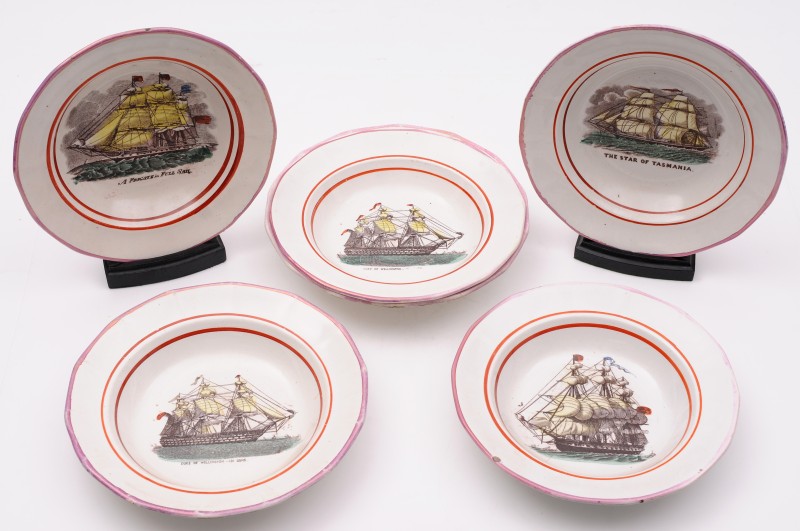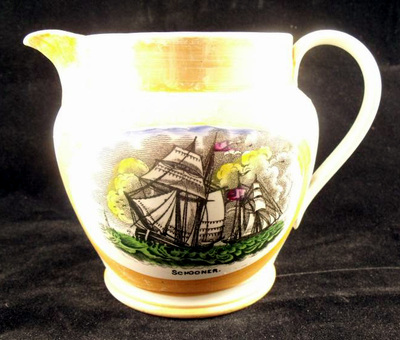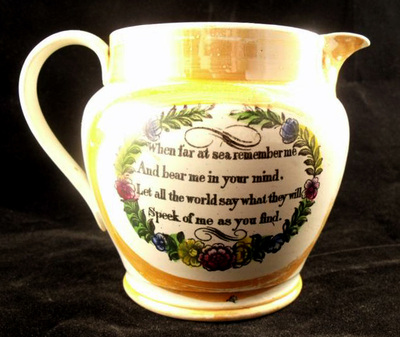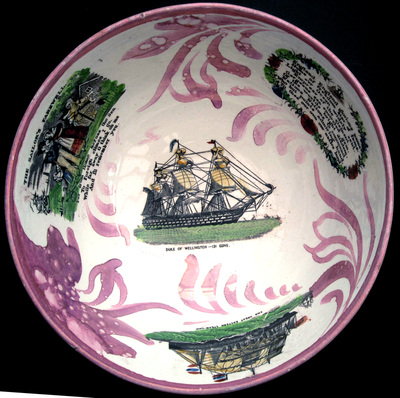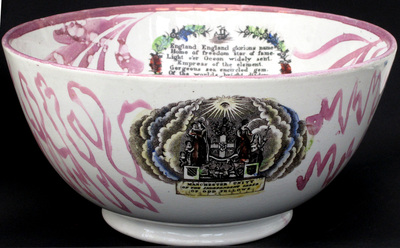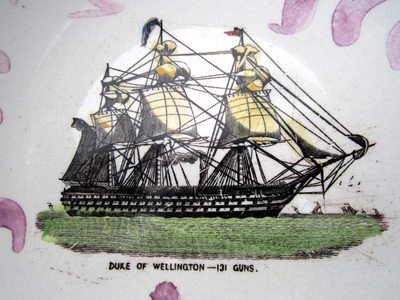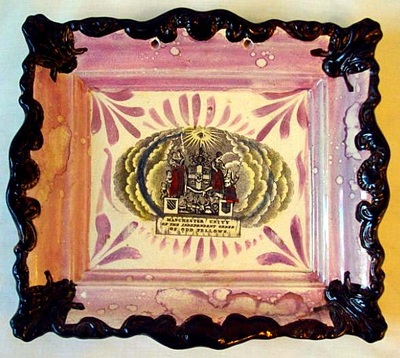|
Aside from the obvious answer - because everybody says so - here are some reasons why I have thought the brown-bordered plaques originated at Scott's. Reason 1Because there's a photo of a Scott-impressed bowl with the 'Great Eastern' transfer in Baker. Baker's book, 'Sunderland Pottery', is the best and most reliable source of information on the subject. His chapter on 'Southwick or Scott's Pottery' has only a handful of photos of Scott transfer-printed lustre items. The Great Eastern, as the first example shown, has star billing. However, Baker takes pains in the text to point out that 'the transfers used by Scott's were frequently the same as those used by the nearby Wear (Moore's) Pottery. Moreover, according to the firm's records Scott's supplied earthenware to Moore's Wear Pottery [...] presumably plain for decoration.' Nowhere does Baker suggest that Scott made the brown-bordered plaques. Reason 2More ship transfers appear on soup bowls with the Scott impress, than appear on Moore-impressed plaques. I've seen plaques with The Duke of Wellington and La Bretagne transfers with the Moore impress, but on the soup bowls Scott takes ownership of the set, marking them 'Scott' over an impressed letter. However, we know the ship transfers originated at Moore's. The 'Prepare' soup bowl below, with an indistinct Scott impress, has the Moore plate 4 transfer. So the argument that the soup bowls are marked 'Scott', therefore Scott's made the brown-bordered plaques, doesn't necessarily follow. I'd assumed the soup bowls to be late (post 1870), but, perhaps tellingly, I haven't yet seen them with the later ship transfers: The Unfortunate London, Great Australia, Brig, Schooner or Truelove from Hull. So it's possible that the bowls above pre-date 1865 and were made at the same time as the brown-bordered plaques. However, soup bowls also appear with the shrill enamels of the orange-lustre period (see below). Isn't it possible that Scott's marked the soup bowls so diligently because they were sending them to another pottery, whether Moore's or Sheepfolds Warehouse, for decoration? Reason 3The two transfers below showed traces of flowers on the right hand side, from another transfer on the same copper plate. Scott items were often decorated with flowers around transfers (see below), so I leapt upon that to strengthen the Scott attribution. (Moore also decorated items with flowers in the 1840s, but they are different to those below.) But I was wrong. Look at the jug below, which pairs the Schooner transfer with the verse 'When far at sea remember me'. The two transfers were side by side on the copper transfer plate, and very close together. When cutting up the printed-tissue sheet of transfers the decorator snipped off a bit of leaf and petal. Incidentally, the jug above is attributed to Scott, but from the orange-lustre period of transfer sharing. To my knowledge, and crucially, none of the transfers that appears on brown-bordered plaques appears on Scott items with typical flower decoration around the rim. Reason 4There are Scott-impressed items with the same transfers as the brown-bordered plaques and identical decoration. Thanks to Norman Lowe for providing images of the Scott-impressed bowl below. Comparing the enamel and lustre decoration on the bowl below (left images) with the plaques (right images), I don't think there could be any doubt that they were made at the same time, and decorated at the same location. Look at the flags on the Great Eastern, and the identical enamelling on the Sailor's Farewell. So that settles it; Scott must have made the brown-bordered plaques. Really? I don't think so. Now compare a transfer on the bowl (below left) with a Scott group 1 plaque (below right). As always, click to enlarge and move between the images. The verse on the plaque, although the same, clearly comes from a different transfer plate. The enamel decoration on the plaque is done with a lighter touch. And yes, the Scott group 1 transfers also appear on bowls with Scott-impressed marks from the 1860s. N.B. the transfers on these items appear to have come from the Garrison Pottery in 1865, and are, I think, the ones on the transfer plate donated to the Ball family to the Sunderland Museum. So above are three bowls with the Scott impress, apparently made around the same time. And yet, the first bowl is decorated in a completely different way to the other two. It has transfers from different copper plates, no typical Scott flower decoration, and the enamels are more heavily applied. What better explanation than it, and the brown-bordered plaques, were decorated at another location: Moore's?
Reattributing all the brown-bordered plaques on this site, and relabelling all my files, will be a major undertaking. That's why I've laboured over this so intensively. If anyone has information or items which might throw some light on a Scott attribution for the brown-bordered plaques, I promise to give it my closest attention!
1 Comment
Elizabeth Gardner
9/16/2014 04:35:45 pm
I have just read your article and thought My Family History may be of interest on the subject. My GG Grandfather was a friend, worked with and cousin of Anthony Scott. After His death in 1868 my G Grandfather worked for Moores Pottery while rearing His younger siblings and furthering His education before immigrating to Australia. Perhaps the connection between Moores and Scotts Potteries was close.
Reply
Leave a Reply. |
AuthorStephen Smith lives in London, and is always happy to hear from other collectors. If you have an interesting collection of plaques, and are based in the UK, he will photograph them for you. Free advice given regarding selling and dispersal of a collection, or to those wishing to start one. Just get in touch... Archives
February 2022
AcknowledgementsThis website is indebted to collectors, dealers and enthusiasts who have shared their knowledge or photos. In particular: Ian Holmes, Stephen Duckworth, Dick Henrywood, Norman Lowe, Keith Lovell, Donald H Ryan, Harold Crowder, Jack and Joyce Cockerill, Myrna Schkolne, Elinor Penna, Ian Sharp, Shauna Gregg at the Sunderland Museum, Keith Bell, Martyn Edgell, and Liz Denton.
|
